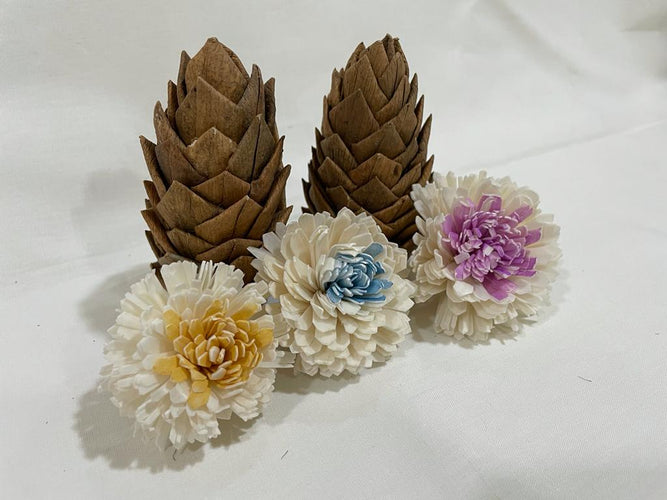Sholapith art, also known as "Indian cork," is a traditional craft that has been cherished for centuries, particularly in the eastern regions of India, such as West Bengal, Assam, and Odisha. This exquisite art form involves creating intricate and delicate sculptures using the white, spongy core of the shola plant (Aeschynomene aspera). The craftsmanship of Sholapith artists is celebrated for its elegance, purity, and cultural significance, often associated with religious and ceremonial purposes.
Sholapith art is characterized by its themes rooted in religious and cultural traditions. The most common themes include idols of Hindu gods and goddesses, particularly Durga, Lakshmi, and Saraswati, as well as other deities like Ganesha and Kali. Apart from religious figures, Sholapith artists also create decorative items like crowns, garlands, wedding accessories, and intricate floral designs.
The style of Sholapith art is marked by its intricate detailing, delicate craftsmanship, and an ethereal, almost lifelike quality. The art form is known for its purity, as the white color of Sholapith symbolizes sanctity and spirituality. The softness of the material allows for the creation of flowing, graceful forms, giving the sculptures a sense of movement and life.
History and Legend
The history of Sholapith art dates back to ancient times, with its origins deeply rooted in the rural traditions of Bengal. The craft was primarily practiced by the 'Malakar' community, who were skilled in creating decorative items and idols for various religious ceremonies. Over the centuries, Sholapith art has evolved from simple decorative pieces to more elaborate and intricate designs, reflecting the changing tastes and demands of society. The craft gained prominence during the British colonial period when it was showcased in various exhibitions, drawing attention to its unique beauty and craftsmanship.
There is a popular legend associated with Sholapith art that adds a mystical charm to its history. It is believed that the goddess Durga, the revered deity in Hinduism, was so impressed with the beauty of Sholapith sculptures that she blessed the Malakar community with the divine skill to create exquisite idols from this humble material. This legend underscores the religious significance of Sholapith art, particularly in the making of idols for Durga Puja, one of the most important festivals in Bengal.
Material and Method
Sholapith is derived from the shola plant, a milky-white, spongy material that grows in the marshy wetlands of Bengal. The process of creating Sholapith art begins with harvesting the shola plant, which is then peeled to extract the soft, white core. This core is cut into thin strips or sheets, which are then molded and shaped into various forms using simple tools like knives, scissors, and bamboo sticks.
The pliable nature of Sholapith allows artisans to craft intricate designs with fine detailing. The art form requires a high level of precision and skill, as the material is delicate and can easily break if not handled with care. Once the desired shape is achieved, the pieces are often painted or decorated with colors and ornaments to enhance their visual appeal.
Significance
Sholapith art holds significant cultural and religious value, particularly in the context of Bengal's traditional festivals and ceremonies. The use of Sholapith in crafting idols for Durga Puja is perhaps the most notable example of its cultural importance. These idols are revered not only for their beauty but also for their symbolic representation of purity and divinity. Beyond its religious significance, Sholapith art is also valued as a symbol of Bengal's rich cultural heritage. The craft represents the skill, creativity, and artistic sensibility of the region's artisans, who have preserved and passed down this tradition through generations. In recent times, Sholapith art has gained recognition on a global scale, with artists experimenting with new themes and styles, thereby ensuring the continued relevance and appreciation of this exquisite art form.
FAQs
Is Sholapith art eco-friendly?
Yes, Sholapith art is eco-friendly. The shola plant is a natural, renewable resource, and the crafting process involves minimal environmental impact, making it a sustainable art form.
Can Sholapith art be customized?
Yes! MeMeraki offers customization options for Sholapith art, allowing you to request specific designs, sizes, or patterns. Please check with us for availability and details on custom orders.
Why should I purchase Sholapith art?
Purchasing Sholapith art supports the livelihoods of traditional artisans and helps preserve a unique cultural heritage. Additionally, these pieces add a touch of elegance and cultural significance to your home decor.
Show Less
